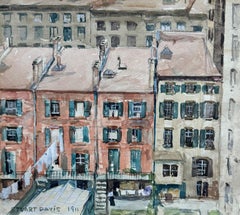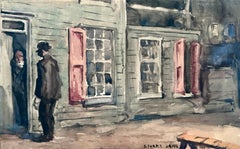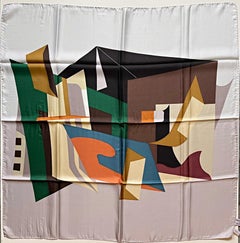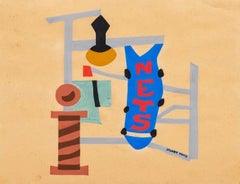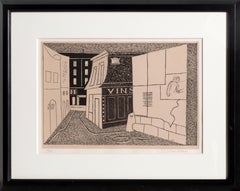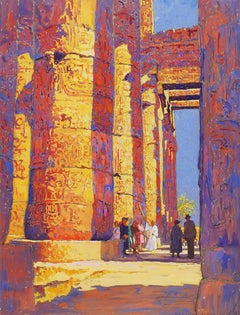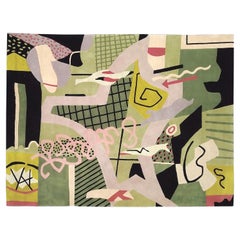Stuart Davis Art
to
1
9
8
6
3
2
2
1
1
Returnable Items Only
"Backyards" Early 20th Century Watercolor Fauvism Social Realism American Scene
By Stuart Davis
Located in New York, NY
"Backyards" Early 20th Century Watercolor Fauvism Social Realism American Scene
Note: We have three similar in style works from 1911 available now on 1stDibs. All are framed identic...
Category
1910s American Realist Stuart Davis Art
Materials
Paper, Watercolor
Answering the Door Early 20th Century w/c Fauvism Social Realism American Scene
By Stuart Davis
Located in New York, NY
Answering the Door Early 20th Century w/c Fauvism Social Realism American Scene
Note: We have three similar in style works from 1911 available now on 1stDibs. All are framed identi...
Category
1910s American Realist Stuart Davis Art
Materials
Paper, Watercolor
Two Men on a Street Early 20th Century w/c Fauvism Social Realism American Scene
By Stuart Davis
Located in New York, NY
Two Men on a Street Early 20th Century w/c Fauvism Social Realism American Scene
Note: We have three similar in style works from 1911 available now on 1stDibs. All are framed identi...
Category
Early 1900s American Realist Stuart Davis Art
Materials
Paper, Watercolor
Eggbeater 1: 34 Square inch Limited Edition Silk Scarf, for the Whitney Museum
By Stuart Davis
Located in New York, NY
Stuart Davis
Eggbeater No. 1 Silk Scarf, ca. 1980
100% silks scarf
34 × 34 inches (the smaller measurements shown are after the scarf is folded, to minimize shipping costs, as it sh...
Category
Mid-20th Century American Modern Stuart Davis Art
Materials
Silk, Screen
"NY Street Signs" Mid-20th Century WPA 1938 Modernist Abstract Realism Pop Art
By Stuart Davis
Located in New York, NY
"NY Street Signs" Mid-20th Century WPA 1938 Modernist Abstract Realism Pop Art
Stuart Davis (American, 1892-1964) "Street Signs" Modernist gouache and traces of pencil on paper in t...
Category
1930s American Modern Stuart Davis Art
Materials
Paper, Gouache, Pencil
Rue des Rats, Modernist Lithograph by Stuart Davis 1928
By Stuart Davis
Located in Long Island City, NY
A modernist lithograph by American artist Stuart Davis. In this cityscape of Paris he begins to show his inclinations towards Cubism, with the slightly skewed perspective and the fla...
Category
1920s American Modern Stuart Davis Art
Materials
Lithograph
Country Life Illustration
By Stuart Davis
Located in Miami, FL
Early work when Stuart Davis was an illustrator.
Christie's, New York
Catalogue Raisonné
Category
1920s American Realist Stuart Davis Art
Materials
Pencil, India Ink
ARCH NO. 1
By Stuart Davis
Located in Portland, ME
Davis, Stuart. ARCH NO. 1. Lithograph, 1929. Edition of 30. Numbered "23/30" and signed in pencil. 8 3/4 x 13 inches, 225 x 275 mm. In excellent condition.
Category
American Modern Stuart Davis Art
Materials
Lithograph
Country Life
By Stuart Davis
Located in Miami, FL
Early work when Stuart Davis was an illustrator.
Christie's, New York
Catalogue Raisonné
Category
1920s American Realist Stuart Davis Art
Materials
India Ink, Pencil
Related Items
Tourists Viewing the Temple of Karnak, Egypt
By Eleanor Parke Custis
Located in New York, NY
Eleanor Park Custis painted scenes as varied as the artist's travels: from her hometown of Washington, D.C., to the coastal towns of New England; from the prosperous fishing villages of Brittany, to Venice and the mountain villages and lakes of northern Italy.
While Custis's subjects are diverse, her style is consistent and distinctive throughout this body of work. Her use of flat areas of color delineated by dark contours is reminiscent of the aesthetics of woodblock printing. Like many artists of the day, she was profoundly influenced by Japanese woodblock prints, and her adaptation of the aesthetic by 1924 led to her most productive artistic period.
Eleanor Custis hailed from a socially prominent Washington, D.C., family. She was distantly related to Martha Custis Washington, America's first First Lady. Custis began three years of formal art training in the autumn of 1915 at the Corcoran School of Art in Washington, and was guided and inspired by Impressionist artist Edmund C. Tarbell, one of the Ten American Painters, who became the Corcoran School's principal in 1918. Custis exhibited widely in many of the Washington art societies and clubs for much of her career. She was also a frequent exhibitor at the Grand Central Art Galleries in New York City; her last one-woman show there was in April 1945.
Custis's mature style emerged in scenes of the streets, wharves, and drydocks of seacoast villages from Maine to Massachusetts, which she visited during the summers of 1924 and 1925. She was working in Gloucester, Massachusetts in August 1924, and painted several gouaches of the town's wharves and winding streets, including In Gloucester Harbor and At the Drydock, Gloucester. During her stay, Custis may have met Jane Peterson or at least must have seen her work, the best of which was executed in Gloucester during the preceding ten years. The similarity between their styles is unmistakable, but, while it may be tempting to suggest that Custis was influenced by Peterson during her summer in Gloucester, the connection between their work is probably more a case of shared aesthetics and common European influences.
Custis expanded her subject repertoire with three trips to Europe between 1926 and 1929, and was inspired by the Old World charm of Holland, northern France, Switzerland, and Italy, leading to such works as New Kirk, Delft, Holland, Market Day in Quimper, At the Foot of the Matterhorn, and The Town Square, Varenna. A Mediterranean cruise in 1934 introduced her to the Near East, and the bustling, colorful streets and bazaars of Cairo, captured in works like A Street in Cairo, Egypt and A Moroccan Jug...
Category
20th Century American Realist Stuart Davis Art
Materials
Paper, Gouache
Toreros (4 Original Lithographs by Pablo Picasso and Jamie Sabartes)
By Pablo Picasso
Located in New York, NY
Sabartes, Jaime
Picasso – Toreros with four original lithographs
Publisher: New York & Paris: George Braziller & Andre Sauret, 1961. First edition.
Ha...
Category
1960s Modern Stuart Davis Art
Materials
Offset, Lithograph
'Sunset Landscape', Hamburg, Rivne, Volhynia, Rivne Museum
Located in Santa Cruz, CA
Signed lower right, 'G. Kosmiadi' for Georg Kosmiadi (Ukranian-German, 1886-1967) and dated, '66'; additionally signed verso, 'Georg Kosmiadi', inscribed with serial number and dated, '20/9/66'.
Georg Kosmiadi was a resident of Rivne before moving to Hamburg in 1940 where he worked as an art teacher. Kosmiadi exhibited at the Rivne Regional Museum and a regional art...
Category
1960s Abstract Impressionist Stuart Davis Art
Materials
Paper, Gouache
Sumac, colorful Abstract Impressionist landscape gouache
By Sandy Litchfield
Located in New York, NY
Sandy Litchfield found peace and inspiration in regular solitary walks through nature throughout the pandemic. Her most recent body of work diaristically documents her constitutional...
Category
2010s Abstract Impressionist Stuart Davis Art
Materials
Paper, Gouache
Rainstorm Sunset
By Robert Noel Blair
Located in Buffalo, NY
You are viewing a modernist American watercolor painting by Robert Noel Blair.
Robert Noel Blair (American, 1912-2003) was an American artist, painter, sculptor, printmaker and te...
Category
American Modern Stuart Davis Art
Materials
Paper, Watercolor
Gateside Conversation, 1940s Original Signed Lithograph by Thomas Hart Benton
By Thomas Hart Benton
Located in Denver, CO
'Gateside Conversation' is an original signed lithograph by Thomas Hart Benton (1889-1975) from 1946. Singed by the artist in the lower right margin and titled verso. Portrays a figu...
Category
1940s American Modern Stuart Davis Art
Materials
Paper, Lithograph
Prodigal Son
By Thomas Hart Benton
Located in London, GB
A fine impression with full margins published by Associated American Artists with their information label present - pictured in Art and Popular Religion in Evangelical America, 1815-...
Category
1930s American Modern Stuart Davis Art
Materials
Lithograph
Gustav Melcher ( German, 1898 -?) Boats off Venice Italy Ink Water Color c. 1918
By Gustav Melcher
Located in Meinisberg, CH
Gustav Melcher
(German, 1898-?)
Segelschiffe vor Venedig - Sailing ships off Venice
• India ink, water colour wash
• Visible image ca. 11.5 x 18 cm
• Glased Frame ca. 20 x 25 cm
• Verso various inscriptions
• Signed lower right
Gustav Melcher was a German painter and a pioneer in film, film criticism and film theory and created this clever little picture of the skyline of Venice with various vessels.
Going by the various inscriptions an the backing paper, this drawing was made in 1918 when Gustav was twenty years old and passed on three years later to Gertrud Melcher on the 1. 2. 1921. I have no reasons to doubt this information. The small drawing is still in its unopened frame, so maybe there is more information to be discovered , however this will be the privilege of the next owner.
The picture also has retained its original antique frame – note that it has lost over the years various sections of the gesso decoration.
The very precisely executed drawing is most enjoyable to look at and doing so, remember you are looking through the eyes of a young man, who saw this foreign sea cape over a century ago.
Thank you for your interest and please note, that I offer free worldwide shipping on all my items.
Gustav Melcher began his studies at the Düsseldorfer Kunstakademie under Peter Janssen and Eduard von Gebhardt. Originaly he was interested in figurative and portrait painting, but after time he decided to pursue the depiction of land- and marinescapes. Durin his studies the young artist undertook trips to visit England, Scotland, Belgium and France and he joined the artist society Malkasten. It was in those days he would hold speeches to his colleges about this new invention called ‘Kintopp’ – Melcher was a great advocate of the moving pictures...
Category
1910s Naturalistic Stuart Davis Art
Materials
India Ink, Paper, Watercolor
Gustav MelcherGustav Melcher ( German, 1898 -?) Boats off Venice Italy Ink Water Color c. 1918, 1918
Free Shipping
H 7.88 in W 9.85 in D 0.79 in
Mid Century Mazatlan Beach Catamaran Figurative Landscape Watercolor
By William A. Corbett
Located in Soquel, CA
Vibrant figurative seascape of a beach in Mazatlan, Mexico with several figures and a catamaran reflecting beautifully in the shallow water by William A. Corbett (American. 1914-1960). Titled "Beach- Mazatlan" on verso. Signed "William Corbett" in lower left corner. Presented in a simple wood frame, with a double mat of off-white silk and royal blue with plexiglass. Image size: 22”H x 14.75”L
William A. Corbett began drawing at an early age. He constructed signs and displays for theaters and nightclubs around Pittsburg. He studied art with Vincent Nesbert at the Pittsburg Art Institute and with Robert Gwathmoy, Roy Hilton, and Robert Laper at the Carnegie Institute of Technology. He also studied painting and sculpture at the Louisville Art Center. Corbett was in the Army Engineers at Fort Knox, Kentucky where he studied, practiced, and had exhibits with army artists there from 1941-1943. He was very much interested in materials and technique, content and style in painting. His favorite Artists were El Greco, Leonardo, Rembrandt, Renoir, Burchfield, and Andrew Wyeth, Jr. He studied two years at Boston museum School with Karl Zerbe, Daivid Aronson and others. He later designed and did art work for General Outdoor Advertising Co. In 1943, he married Ruth Osborne of Louisville and they had one son, Michael. In 1951 he moved to Fort Lauderdale, Florida with his family.
Exhibitions:
Army Art Show--- 1st Prize in Landscape, 1942
Kentucky & southern Indiana Exhibition-- Honorable
mentions for Fisherman's Curse 1949, Don Q...
Category
1960s American Realist Stuart Davis Art
Materials
Watercolor, Paper
H 27.25 in W 20.25 in D 0.75 in
Ruins of Central City, Vintage 1935 Framed Colorado Modernist Landscape
By Vance Kirkland
Located in Denver, CO
Vintage lithograph titled "Ruins of Central City 31/70" is a modernist landscape with decaying buildings and mountains by Vance Hall Kirkland, from 1935. Presented in a custom black frame with archival materials, outer dimensions measure 25 ⅞ x 29 ⅜ x ⅝ inches. Image sight size is 14 x 17 ¾ inches.
Painting is clean and in very good vintage condition - please contact us for a detailed condition report.
Provenance: Private collection, Denver, Colorado
Expedited and international shipping is available - please contact us for a quote.
About the Artist:
Variously referred to as the "Father of Modern Colorado Painting", "Dean of Colorado Artists", and "Colorado’s pre-eminent artist," Kirkland was an inventive, visionary painter who spent fifty-two years of his fifty-four-year career in Denver. Of the approximately 1,200 paintings he created, about 550 from the first half of his career (1927-1953) are water-based media: acquarelle, gouache, casein and egg tempera, with a few oils. In the latter half of his career (1953-1981) he used oil and his unique oil and water mixture. He also produced five hundred drawings and some ten prints, mostly lithographs on stone, while also engaged in teaching full-time for most of the period.
To show people "something they have never seen before and new ways to look at things," he felt he needed to preserve his artistic freedom. Consequently, he chose to spend his entire professional career in Denver far removed from the established American art centers in the East and Midwest. "By minding my own business and working on my own," he said, "I think it was possible to develop in this part of the country… I’ve developed my kind of work [and] I think my paintings are stronger for having worked that way." The geographical isolation resulting from his choice to stay in Colorado did not impede his creativity, as it did other artists, but in fact contributed to his unique vision.
The son of a dentist, who was disappointed with his [son’s] choice of art as a career, Kirkland flunked freshman watercolor class in 1924 at the Cleveland School of Art (now the Cleveland Institute of Art) for putting colors into his landscapes that did not exist in nature and for competing colors. Not dissuaded, he won first prize for his watercolors in his junior and senior years. [While in Cleveland,] he studied with three influential teachers. Henry Keller, included in the prestigious New York Armory Show in 1913, introduced him to designed realism which he later used in his Colorado landscapes in the 1930s and 1940s. His other teachers were Bill Eastman, who studied with Hans Hofmann and appreciated all the new movements in modern art, and Frank Wilcox, a fine watercolorist.
While a student at the Cleveland School of Art, Kirkland concurrently took liberal arts courses at Western Reserve and the Cleveland School of Education and taught two freshman courses in watercolor and design, receiving his diploma in painting from the school in 1927 by doing four years of work in three. The following year he received a Bachelor of Education in Art degree from the same institution.
In 1929 he assumed the position of founding director of the University of Denver’s School of Art, originally known as the Chappell School of Art. He resigned three years later when the university reneged on its agreement to grant its art courses full recognition toward a Bachelor of Arts degree. His students prevailed on him to continue teaching, resulting in the Kirkland School of Art which he opened in 1932 at 1311 Pearl Street in Denver. The building, where he painted until his death in 1981, formerly was the studio of British-born artist, Henry Read, designer of the City of Denver Seal and one of the original thirteen charter members of the Artists’ Club of Denver, forerunner of the Denver Art Museum. The Kirkland School of Art prospered for the next fourteen years with its courses accredited by the University of Colorado Extension Center in Denver.
The teaching income from his art school and his painting commissions helped him survive the Great Depression. The U.S. Treasury Department’s Section of Fine Arts commissioned from him two post office murals, Cattle Roundup (1938, Eureka, Kansas), and Land Rush (1940, Sayre, Oklahoma). He also did murals for several Denver clients: the Gerald Hughes mansion (1936, later demolished), Arthur Johnson home (1936-37, Seven Drinks of Man), Albany Hotel (1937, later demolished), Neustetter’s Department Store (1937, "History of Costume," three of five saved in 1987 before the building interior was demolished in advance of its condo conversion), and the Denver Country Club (1945, partially destroyed and later painted over).
In 1953 the Ford Times, published by the Ford Motor Company, commissioned Kirkland along with fellow Denver artists, William Sanderson and Richard Sorby, to paint six watercolors each for the publication. Their work appeared in articles [about] Colorado entitled, "Take to the High Road" (of the Colorado Rockies) by Alicita and Warren Hamilton. Kirkland sketched the mountain passes and high roads in the area of Mount Evans, Independence Pass near Aspen, and Trail Ridge Road in Rocky Mountain National Park.
In 1946 Kirkland closed his art school when the University of Denver rehired him as director of its School of Art and chairman of the Division of Arts and Humanities. In 1957 the University gave him its highest honor – the "University Lecturer Award." When he retired in 1969 as Professor of Art Emeritus to become a full-time painter, the School of Arts was the university’s largest undergraduate department. In 1971 Governor John Love presented Kirkland the State of Colorado Arts and Humanities Award. In addition to his dual positions as artist and teacher in Denver for more than half a century, he served the Denver Art Museum as a trustee, chairman of the accessions committee, member of the exhibitions committee, curator of European and American art, and honorary curator of painting and sculpture. He also won the battle with the museum’s old guard to establish a department of modern and contemporary art. Additionally, he was one of the fifty-two founding members of the Denver Artists Guild which included most of Colorado’s leading artists who greatly contributed to the state’s cultural history.
Kirkland developed five major painting periods during his life encompassing various series with some chronological overlap: Designed Realism (1927-1944); Surrealism (1939-1954); Hard Edge Abstraction, including the Timberline Abstraction Series (1947-1957); Abstract Expressionism with four series – Nebulae, Roman, Asian, and Pure Abstractions (1951-1964); and the Dot Paintings with five series – Energy of Vibrations, Mysteries, Explosions, Forces, and Pure Abstractions (1963-1981).
Nevadaville (1931), a watercolor, belongs to Kirkland’s initial period of Designed Realism. Adapting nature by redesigning the realism he saw on location in Colorado allowed him to be "more concerned with the importance of the painting rather than the importance of the landscape." He noted that the rhythms his Cleveland teacher, Henry Keller, "found in nature created a certain movement in his paintings… [that moved] away from the static element of a lot of realistic, representational painting." Kirkland, along with fellow watercolorist Elisabeth Spalding, were some of the first Denver artists interesting themselves in Colorado’s nineteenth-century mining towns west of Denver. They offered an alternative to the overwrought cowboy and Indian subject matter of the previous generation; while the human and architectural components of the mining towns provided a welcome break from the predominant nineteenth-century landscape tradition.
Vibrations of Two Yellows in Space (1970), one of Kirkland’s small subseries of "Open Sun Paintings," occupies the final phase in his first series of dot paintings, Energy of Vibrations in Space (1963-1972). Many pieces in the series incorporate his unique mixture of oil paint and water which he developed in the early 1950s. The work in the subseries – a challenge to the viewer’s optic nerve – constitutes his contribution to the international realm of Op Art. Recalling the theory of pulsating galaxies and the universe, he used dots applied with dowels of different sizes to surround and leave round open spaces letting the gradient background show through. Because of the color contrast between the two, the "suns" either recede into the background or jump out in the foreground, creating the powerful pulsing effect.
During his lifetime he assembled on a limited budget an extensive collection of fine and decorative art and furniture. His collecting passion dated from his student days when he used his prize money from the Cleveland School of Art to purchase a watercolor by William Eastman and a now-famous set of Russian musician figures by Alexander Blazys, both of whom were his professors. After Kirkland’s death, the Denver Art Museum received a large bequest that included paintings by Roberto Matta, Gene Davis, Charles Burchfield, and Richard Anuszkiewicz (the two latter-named also alumni of the Cleveland Institute of Art); prints by Arthur B. Davies, Roberto Matta, Pablo Picasso, and Robert Rauschenberg; and a sculpture by Ossip Zadkine.
Kirkland posthumously was the subject of a television documentary, "Vance Kirkland’s Visual Language," aired on over one hundred PBS television stations (1994-96), and in 1999 a six-scene biographical ballet choreographed by Martin Friedmann with scenario provided by Hugh Grant, founder and director of the Kirkland Museum of Fine & Decorative Art in Denver. Historic Denver also posthumously honored Kirkland as part of the Colorado 100.
From 1997 to 2000 Kirkland’s solo exhibition was hosted by thirteen European museums: Fondazione Muduma, Milan; Sala Parpalló Museum Complex, València; Stadtmuseum, Düsseldorf; Frankfurter Kunstverein; Museum of Modern Art, Vienna; Kiscelli Múzeum and the Museum of Fine Arts, Budapest; Czech Museum of Fine Arts, Prague; National Museum, Warsaw; State Gallery of the Art of Poland, Sopot/Gdańsk, National Museum of Art, Kaunas, Lithuania; Latvian Foreign Art Museum, Riga; and the State Russian Museum, St. Petersburg.
Solo Exhibitions: Denver Art Museum (1930, 1935, 1939-40, 1942, 1972, 1978-retrospective, 1988, 1998); Colorado Springs Fine Arts Center (1943); Knoedler & Company, New York (1946, 1948, 1952); Pogzeba Art Gallery, Denver (1959); Galleria Schneider, Rome (1960); Birger Sandzén Memorial Gallery, Lindsborg, Kansas (1964-65,1977); Genesis Galleries, Ltd., New York (1978); Valhalla Gallery, Wichita, Kansas (1979); Inkfish Gallery, Denver (1980); Colorado State University, Fort Collins (1981- memorial exhibition); Boulder Center for the Visual Arts (1985); University of Denver, Schwayder Art Gallery (1991).
Group Exhibitions (selected): "May Show," Cleveland Museum of Art (1927-28); "Western Annuals," Denver Art Museum (1929-1957, 1964, 1966, 1968, 1971); "International Exhibition of Watercolors, Pastels, Drawings and Monotypes," Art Institute of Chicago (1930-1946); "Abstract and Surrealist American Art," Art Institute of Chicago (1947-48, traveled to ten other American museums); "Midwest Artists Exhibition," Kansas City Art Institute (1932, 1937, 1939-1942); Dallas Museum of Art (1933, 1960); San Diego Museum of Art (1941); "Artists for Victory," Metropolitan Museum of Art (1942); "United Nations Artists in America," Argent Galleries, New York (1943); "California Watercolor Society," Los Angeles County Museum (1943-1945); "Survey of Romantic Painting," Museum of Modern Art, New York (1945); New Mexico Museum of Art, Santa Fe (1945, 1951); Knoedler & Company, New York (1946-57; co-show with Max Ernest, 1950; co-show with Bernard Buffet, 1952); Joslyn Art Museum, Omaha (1948, 1956); Philbrook Art Center, Tulsa, Oklahoma (1951); "Contemporary American Painting," University of Illinois, Urbana (1952); University of Utah, Salt Lake (1952-53); Oakland Art Museum (1954-55); "Reality and Fantasy, 1900-54," Walker Art Center, Minneapolis (1954); "Art U.S.A.," Madison Square Garden, New York (1958); Roswell Museum and Art Center, New Mexico (1961); Burpee Art Museum, Rockford, Illinois (1965-68); University of Arizona Art...
Category
1930s American Modern Stuart Davis Art
Materials
Paper, Lithograph
H 25.75 in W 29.5 in D 0.5 in
Original "Back Our Girls Over There, YWCA vintage WW1 poster
By Clarence Underwood
Located in Spokane, WA
Original Back Our Girls Over There Y.W.C.A. WW1 antique poster: Linen-backed original Beautiful Y.W.C.A. Telephone operator sitting at the control pane...
Category
1910s American Modern Stuart Davis Art
Materials
Lithograph
H 28 in W 21.5 in D 0.05 in
Down the River
By Thomas Hart Benton
Located in London, GB
A fine impression of this popular Benton image with good margins.
Category
1930s American Modern Stuart Davis Art
Materials
Lithograph
Previously Available Items
Stuart Davis 'Flying Carpet' by V'Soske, Grand Rapids, Michigan
By Stuart Davis
Located in Ft. Lauderdale, FL
Stuart Davis, American (1892-1964). 'Flying Carpet' Designed in 1942 and executed in 1986 by V'Soske, Grand Rapids, Michigan. Measures 9' x 12'. Carpet is wool. Label attached to und...
Category
1980s American Mid-Century Modern Vintage Stuart Davis Art
Materials
Wool
Landscape, Bass Rocks
By Stuart Davis
Located in New York, NY
A very good impression of this color screenprint. Edition of 100. Signed in pencil, lower left. Published by Jack Rich, New York, with the original label.
Based on the oil painting by Davis "Bass Rocks, No. 1," currently in the collection of the Wichita Art...
Category
1940s Modern Stuart Davis Art
Materials
Color, Screen
Tournos-Poster, 1976 New York Graphic Society. Printed in Switzerland
By Stuart Davis
Located in Clinton Township, MI
1976 New York Graphic Society, Ltd. Printed in Switzerland. The poster measures 35 x 27 inches and is unframed. The piece is in Good Condition-m...
Category
1970s Stuart Davis Art
Materials
Lithograph
RUE de L'ECHAUDE
By Stuart Davis
Located in Santa Monica, CA
STUART DAVIS (1892 – 1964)
RUE de L’ECHAUDE, 1929 (Cole, Meyers 12)
Lithograph on chine-applique. Signed, no. 28/30. 9 7/8 x 14 ¾”. Full?
large she...
Category
1920s American Modern Stuart Davis Art
Materials
Lithograph
1931 Stuart Davis 'Coffee Pot' Serigraph from the Downtown Gallery
By Stuart Davis
Located in Hyattsville, MD
Rare extremely Serigraph of 'Coffee Pot.' on Heavy Stock paper. This print was produced in 1931, same year that the original gouache was done. This very low run was produced by Davis...
Category
1930s American Modern Vintage Stuart Davis Art
Stuart Davis art for sale on 1stDibs.
Find a wide variety of authentic Stuart Davis available for sale on 1stDibs. You can also browse by medium to find art by Stuart Davis in pencil, india ink, ink and more. Much of the original work by this artist or collective was created during the 20th century and is mostly associated with the modern style. Not every interior allows for large Stuart Davis, so small editions measuring 10 inches across are available. Customers who are interested in this artist might also find the work of Bror Julius Olsson Nordfeldt, Fred Nagler, and Dale Nichols. Stuart Davis prices can differ depending upon medium, time period and other attributes. On 1stDibs, the price for these items starts at $700 and tops out at $125,000, while the average work can sell for $9,500.
Artists Similar to Stuart Davis
Questions About Stuart Davis Art
- 1stDibs ExpertApril 5, 2022Stuart Davis's art style is largely Cubist. He used the hard-edge painting technique to create dramatic differences in color. Many of his works draw inspiration from jazz and swing music, and historians credit him with influencing the Pop artists that emerged later in the 20th century. On 1stDibs, shop a collection of Stuart Davis art.
